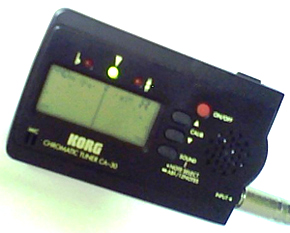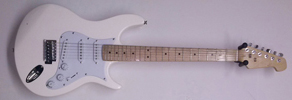Once all the strings are placed you must know how to tune the guitar. All guitars are tune the same way no matter if they Classical, Electric or Acoustic. In the other hand there are other ways to tune the guitar (other tunings that are not the standard but they are used only exceptionally).
If you have an electronic tuner, you can see names of notes in the screen (like E, A, D...) when you play the strings of the guitar. To tune the guitar with an electronic tuner, you need to play one by one the strings of the guitar (open, not stepping in any fret) and try to tighten or loosen (in its peg of the peg box) until you see in the screen of the tuner the name of note of that string. These are the notes of each string: the 6th (the one on top) E, the 5th A, the 4th D, the 3rd G, the 2nd B and the 1st E. When you see the right note in the screen of your tuner then you have to tighten or loosen each string. Tuners use to have an arrow that points at the middle of the screen, a green light or some other signal that means the string is tuned. You have to get that correct result in each string with these notes.

The bass guitar has only 4 strings that are the guitar's 4 lowest strings (the top 4) but an octave lower. They sound the same as in the guitar, the notes are the same but lower. The bass doesn't have the first and second strings of the guitar (counting them from down to up as it uses to be counted) so the 6th string of the guitar is the 4th in the bass guitar. The notes of each open string of the bass are: the 4th (the one on top) E, the 3rd A, the 2nd D and the 1st G. The tuner must show that the bass strings are tuned in these notes.
When you put new strings in the guitar, it's necessary to tune the guitar sevaral times before it comes stable. That's because when you put a string in the guitar that string change from "rest" condition to tension. Strings use to back back to the immediate physical state they where before, so they will untune at the beginning until they get stable. It's not a defect of your guitar.
In this website you can also find some tips for buying a guitar, explanations about how to take care of your guitar, the different types of guitars that exists or the interesting relationship between physics and music or learn a bit of Harmony and Tonality. You can also find information about the guitar classes that Miguel Angel González Aguado offers including guitar lessons online in your own home from any part of the World.
